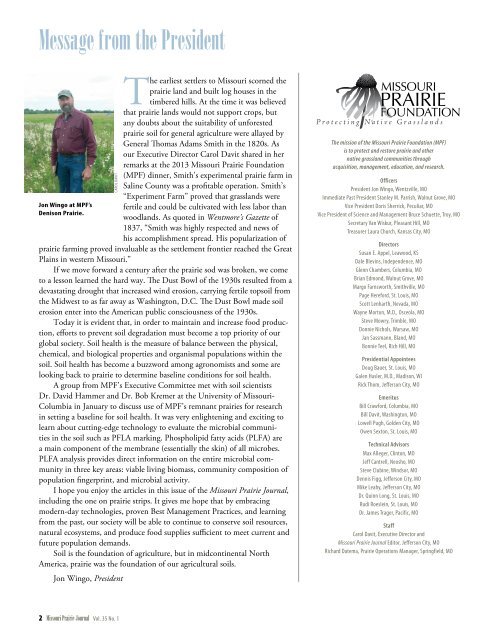l4c9lj6
l4c9lj6
l4c9lj6
You also want an ePaper? Increase the reach of your titles
YUMPU automatically turns print PDFs into web optimized ePapers that Google loves.
Message from the President<br />
Jon Wingo at MPF’s<br />
Denison Prairie.<br />
Carol Davit<br />
The earliest settlers to Missouri scorned the<br />
prairie land and built log houses in the<br />
timbered hills. At the time it was believed<br />
that prairie lands would not support crops, but<br />
any doubts about the suitability of unforested<br />
prairie soil for general agriculture were allayed by<br />
General Thomas Adams Smith in the 1820s. As<br />
our Executive Director Carol Davit shared in her<br />
remarks at the 2013 Missouri Prairie Foundation<br />
(MPF) dinner, Smith’s experimental prairie farm in<br />
Saline County was a profitable operation. Smith’s<br />
“Experiment Farm” proved that grasslands were<br />
fertile and could be cultivated with less labor than<br />
woodlands. As quoted in Wentmore’s Gazette of<br />
1837, “Smith was highly respected and news of<br />
his accomplishment spread. His popularization of<br />
prairie farming proved invaluable as the settlement frontier reached the Great<br />
Plains in western Missouri.”<br />
If we move forward a century after the prairie sod was broken, we come<br />
to a lesson learned the hard way. The Dust Bowl of the 1930s resulted from a<br />
devastating drought that increased wind erosion, carrying fertile topsoil from<br />
the Midwest to as far away as Washington, D.C. The Dust Bowl made soil<br />
erosion enter into the American public consciousness of the 1930s.<br />
Today it is evident that, in order to maintain and increase food production,<br />
efforts to prevent soil degradation must become a top priority of our<br />
global society. Soil health is the measure of balance between the physical,<br />
chemical, and biological properties and organismal populations within the<br />
soil. Soil health has become a buzzword among agronomists and some are<br />
looking back to prairie to determine baseline conditions for soil health.<br />
A group from MPF’s Executive Committee met with soil scientists<br />
Dr. David Hammer and Dr. Bob Kremer at the University of Missouri-<br />
Columbia in January to discuss use of MPF’s remnant prairies for research<br />
in setting a baseline for soil health. It was very enlightening and exciting to<br />
learn about cutting-edge technology to evaluate the microbial communities<br />
in the soil such as PFLA marking. Phospholipid fatty acids (PLFA) are<br />
a main component of the membrane (essentially the skin) of all microbes.<br />
PLFA analysis provides direct information on the entire microbial community<br />
in three key areas: viable living biomass, community composition of<br />
population fingerprint, and microbial activity.<br />
I hope you enjoy the articles in this issue of the Missouri Prairie Journal,<br />
including the one on prairie strips. It gives me hope that by embracing<br />
modern-day technologies, proven Best Management Practices, and learning<br />
from the past, our society will be able to continue to conserve soil resources,<br />
natural ecosystems, and produce food supplies sufficient to meet current and<br />
future population demands.<br />
Soil is the foundation of agriculture, but in midcontinental North<br />
America, prairie was the foundation of our agricultural soils.<br />
Jon Wingo, President<br />
The mission of the Missouri Prairie Foundation (MPF)<br />
is to protect and restore prairie and other<br />
native grassland communities through<br />
acquisition, management, education, and research.<br />
Officers<br />
President Jon Wingo, Wentzville, MO<br />
Immediate Past President Stanley M. Parrish, Walnut Grove, MO<br />
Vice President Doris Sherrick, Peculiar, MO<br />
Vice President of Science and Management Bruce Schuette, Troy, MO<br />
Secretary Van Wiskur, Pleasant Hill, MO<br />
Treasurer Laura Church, Kansas City, MO<br />
Directors<br />
Susan E. Appel, Leawood, KS<br />
Dale Blevins, Independence, MO<br />
Glenn Chambers, Columbia, MO<br />
Brian Edmond, Walnut Grove, MO<br />
Margo Farnsworth, Smithville, MO<br />
Page Hereford, St. Louis, MO<br />
Scott Lenharth, Nevada, MO<br />
Wayne Morton, M.D., Osceola, MO<br />
Steve Mowry, Trimble, MO<br />
Donnie Nichols, Warsaw, MO<br />
Jan Sassmann, Bland, MO<br />
Bonnie Teel, Rich Hill, MO<br />
Presidential Appointees<br />
Doug Bauer, St. Louis, MO<br />
Galen Hasler, M.D., Madison, WI<br />
Rick Thom, Jefferson City, MO<br />
Emeritus<br />
Bill Crawford, Columbia, MO<br />
Bill Davit, Washington, MO<br />
Lowell Pugh, Golden City, MO<br />
Owen Sexton, St. Louis, MO<br />
Technical Advisors<br />
Max Alleger, Clinton, MO<br />
Jeff Cantrell, Neosho, MO<br />
Steve Clubine, Windsor, MO<br />
Dennis Figg, Jefferson City, MO<br />
Mike Leahy, Jefferson City, MO<br />
Dr. Quinn Long, St. Louis, MO<br />
Rudi Roeslein, St. Louis, MO<br />
Dr. James Trager, Pacific, MO<br />
Staff<br />
Carol Davit, Executive Director and<br />
Missouri Prairie Journal Editor, Jefferson City, MO<br />
Richard Datema, Prairie Operations Manager, Springfield, MO<br />
2 Missouri Prairie Journal Vol. 35 No. 1


